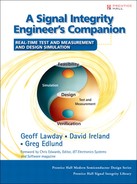Contents
1 Introduction: An Engineer's Companion
1.1 Life Cycle: The Motivation to Develop a Simulation Strategy
1.2 Prototyping: Interconnecting High-Speed Digital Signals
1.4 The Need for Real-Time Test and Measurement
2 Chip-to-Chip Timing and Simulation
2.4 Setup and Hold Constraints
2.5 Common-Clock On-Chip Timing
2.6 Setup and Hold SPICE Simulations
2.9 Common-Clock IO Timing Using a Standard Load
2.10 Limits of the Common-Clock Architecture
2.13 CMOS Differential Receiver
2.15 Receiver Current-Voltage Characteristics
2.18 Output Rise and Fall Times
2.20 Behavioral Modeling of IO Circuits
2.21 Behavioral Model for CMOS Push-Pull Driver
2.22 Behavioral Modeling Assumptions
2.28 Behavioral Modeling Assumptions (Reprise)
2.29 Comparison of SPICE and IBIS Models
2.30 Accuracy and Quality of IO Circuit Models
3 Signal Path Analysis as an Aid to Signal Integrity
3.1 The Transmission Line Environment
3.2 Characteristic Impedance, Reflections, and Signal Integrity
3.3 The Reflection Coefficient, Impedance, and TDR Concepts
3.4 Looking at Real-World Circuit Characteristics
3.6 Differential TDR Measurements
3.7 Frequency Domain Measurements for SI Applications
4.1 Evolution from a Common Ancestor
4.8 Rising and Falling Waveforms
4.9 Interconnect Sensitivity Analysis
4.10 Conductor and Dielectric Losses
4.12 Pin-to-Pin Capacitance Variation
4.13 Length Variation within a Byte Lane
4.15 Vref AC Noise and Resistor Tolerance
4.17 Final Read and Write Timing Budgets
5 Real-Time Measurements: Probing
5.1 The Anatomy of a Modern Oscilloscope Probe
5.7 Advanced Probing Techniques
6 Testing and Debugging: Oscilloscopes and Logic Analyzers
6.1 Fundamentals of Signal Integrity
6.3 Verification Tools: Oscilloscopes
6.4 Verification Tools: Logic Analyzers
6.5 Combining Analog and Digital Measurements
7 Replicating Real-World Signals with Signal Sources
7.1 Observing and Controlling Circuit Behavior
7.3 Signal-Generation Techniques
7.4 Arbitrary Function Generators
7.5 The Arbitrary Waveform Generator
8 Signal Analysis and Compliance
8.2 High-Performance Tools for Compliance Measurements
8.3 Validation and Compliance Measurements
8.4 Understanding Serial Architectures
8.5 Physical Layer Compliance Testing
8.6 Measurements on Optical Signals
8.7 Compliance Measurement Considerations: Analysis
8.11 Transmitter Measurement Examples
8.12 Impedance and Link Measurements
8.13 Receiver Testing Brings Unique Challenges
8.14 Digital Validation and Compliance
9.1 High-Speed Serial Interfaces
9.3 Ideal Driver and Lossy Transmission Line
9.4 Differential Driver with De-emphasis
9.11 Sensitivity Analysis Results
9.12 Model-to-Hardware Correlation
10.3 Overview of the Real-Time Spectrum Analyzer
10.4 How a Real-Time Spectrum Analyzer Works
